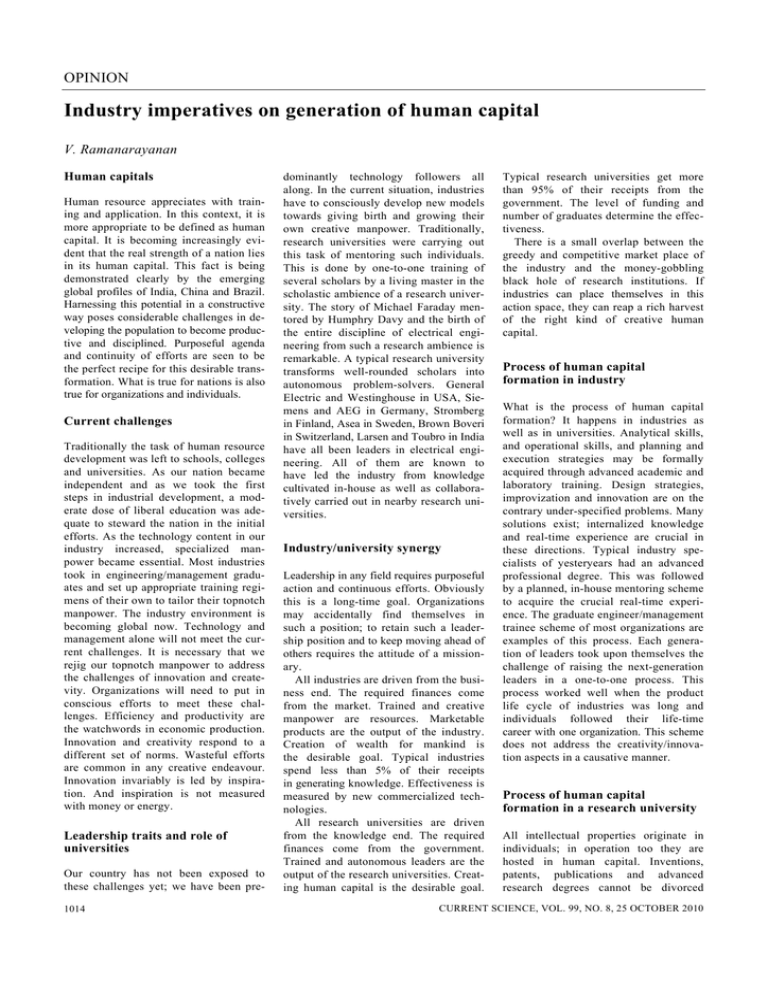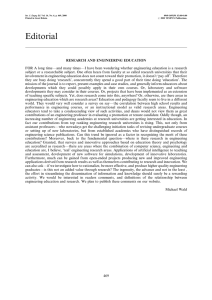Industry imperatives on generation of human capital OPINION Human capitals
advertisement

OPINION Industry imperatives on generation of human capital V. Ramanarayanan Human capitals Human resource appreciates with training and application. In this context, it is more appropriate to be defined as human capital. It is becoming increasingly evident that the real strength of a nation lies in its human capital. This fact is being demonstrated clearly by the emerging global profiles of India, China and Brazil. Harnessing this potential in a constructive way poses considerable challenges in developing the population to become productive and disciplined. Purposeful agenda and continuity of efforts are seen to be the perfect recipe for this desirable transformation. What is true for nations is also true for organizations and individuals. Current challenges Traditionally the task of human resource development was left to schools, colleges and universities. As our nation became independent and as we took the first steps in industrial development, a moderate dose of liberal education was adequate to steward the nation in the initial efforts. As the technology content in our industry increased, specialized manpower became essential. Most industries took in engineering/management graduates and set up appropriate training regimens of their own to tailor their topnotch manpower. The industry environment is becoming global now. Technology and management alone will not meet the current challenges. It is necessary that we rejig our topnotch manpower to address the challenges of innovation and createvity. Organizations will need to put in conscious efforts to meet these challenges. Efficiency and productivity are the watchwords in economic production. Innovation and creativity respond to a different set of norms. Wasteful efforts are common in any creative endeavour. Innovation invariably is led by inspiration. And inspiration is not measured with money or energy. Leadership traits and role of universities Our country has not been exposed to these challenges yet; we have been pre1014 dominantly technology followers all along. In the current situation, industries have to consciously develop new models towards giving birth and growing their own creative manpower. Traditionally, research universities were carrying out this task of mentoring such individuals. This is done by one-to-one training of several scholars by a living master in the scholastic ambience of a research university. The story of Michael Faraday mentored by Humphry Davy and the birth of the entire discipline of electrical engineering from such a research ambience is remarkable. A typical research university transforms well-rounded scholars into autonomous problem-solvers. General Electric and Westinghouse in USA, Siemens and AEG in Germany, Stromberg in Finland, Asea in Sweden, Brown Boveri in Switzerland, Larsen and Toubro in India have all been leaders in electrical engineering. All of them are known to have led the industry from knowledge cultivated in-house as well as collaboratively carried out in nearby research universities. Industry/university synergy Leadership in any field requires purposeful action and continuous efforts. Obviously this is a long-time goal. Organizations may accidentally find themselves in such a position; to retain such a leadership position and to keep moving ahead of others requires the attitude of a missionary. All industries are driven from the business end. The required finances come from the market. Trained and creative manpower are resources. Marketable products are the output of the industry. Creation of wealth for mankind is the desirable goal. Typical industries spend less than 5% of their receipts in generating knowledge. Effectiveness is measured by new commercialized technologies. All research universities are driven from the knowledge end. The required finances come from the government. Trained and autonomous leaders are the output of the research universities. Creating human capital is the desirable goal. Typical research universities get more than 95% of their receipts from the government. The level of funding and number of graduates determine the effectiveness. There is a small overlap between the greedy and competitive market place of the industry and the money-gobbling black hole of research institutions. If industries can place themselves in this action space, they can reap a rich harvest of the right kind of creative human capital. Process of human capital formation in industry What is the process of human capital formation? It happens in industries as well as in universities. Analytical skills, and operational skills, and planning and execution strategies may be formally acquired through advanced academic and laboratory training. Design strategies, improvization and innovation are on the contrary under-specified problems. Many solutions exist; internalized knowledge and real-time experience are crucial in these directions. Typical industry specialists of yesteryears had an advanced professional degree. This was followed by a planned, in-house mentoring scheme to acquire the crucial real-time experience. The graduate engineer/management trainee scheme of most organizations are examples of this process. Each generation of leaders took upon themselves the challenge of raising the next-generation leaders in a one-to-one process. This process worked well when the product life cycle of industries was long and individuals followed their life-time career with one organization. This scheme does not address the creativity/innovation aspects in a causative manner. Process of human capital formation in a research university All intellectual properties originate in individuals; in operation too they are hosted in human capital. Inventions, patents, publications and advanced research degrees cannot be divorced CURRENT SCIENCE, VOL. 99, NO. 8, 25 OCTOBER 2010 OPINION from the individuals originating them. A research university forms human capital through the process of conferment of research degrees. The process has all the required components in a good measure administered in the proper sequence. The prime mover of the process is the teaching/research professor at the research university. The hallmarks of such a faculty are: (i) Effective teaching skills. (ii) A good body of work of practical relevance. (iii) Bandwidth in a range of applications. (iv) Funding support – in terms of sponsored projects. (v) Student support – in terms of student enrolment/ graduation. (vi) Record of relevant publications. (vii) Record of placement of graduates. A successful professor will be running his research laboratory almost like a going concern. He will take in research scholars and teach them from his personal expertise, and will also guide the scholars in acquiring additional academic skills. He will have a substantial consulting base. This will expose the scholars to application needs and work of practical relevance. The non-competitive and open ambience enables the scholars to explore generic issues, current benchmarks, technology bottlenecks and core research issues. A typical research laboratory will be ceased of the critical research issues and will be able to attract research funding on such generic research. The scholars cut their teeth on these research problems with their expertise and learn to innovate. They become competent in the state of the art. They acquire the necessary skills of planning and executing innovation, evaluating and applying the same and defending their work among professional colleagues. In the process, the raw graduate entering a research laboratory matures into an autonomous problem-solver. The process with good exposure to role models instills the essential integrity and professional ethics. The transformation takes about 5–6 years per potential leader. The research degree is the starting point of a life-long union of love (philosophy) with knowledge. Additional postdoctoral exposure in alternate environments will round-off the researcher for a life-long research career. A typical research professor will be able to create about 20–30 such potential leaders in his professional lifespan of about 30–40 years. It may be appreciated that accumulating human capital is a painfully slow process. Multiplication effect of human capital The experienced professionals seeded into the process of university research conferment will get value added manifold. Research engineers in any industry with strong ties to their alma mater and into the research fraternity of the country are of strategic value to any industry. It will be good to have a serious scheme of collaborative research with research professors of nearby universities. Such a scheme will add a lot more intellectual challenges to the high calibre fast-track employees. It will foster a teacher– student relationship between the research professor and the industry by proxy. Such a relationship will go beyond routine contract research and create bonds that will transform the culture of the industry for better. Such a scheme will also ensure that large amount of government funding at these universities gets deployed in meaningful nationally relevant goals. Most universities have formal provisions to facilitate such collaborations. Defence/space/atomic energy sectors currently avail these facilities with remarkable results. Industries in general have a lot to gain by aggressively participating in such collaborations. Financial mobilization Each research graduate in the engineering/physical sciences discipline may need about Rs 10 lakhs per year towards working expenses. A research professor may be counted to have a span of 20 years of collaborative research work with the industry, covering a total of about 50 research graduates. This will translate into a life-time grant of about Rs 10 crores (including 100% university overheads) under working expenses. This works out to Rs 50 lakhs per year. We may provide a similar amount per year towards equipment. Any industry with a university support budget of about Rs 5 crores per year will be able to fully support about five centres of excellence built around five such professors all over the country. This could be a modest starting level of engagement. Action plan The knowledge domain for research work requires to be defined. Here the CURRENT SCIENCE, VOL. 99, NO. 8, 25 OCTOBER 2010 industry is at a relatively strong ground and will be able to readily specify the same. One of the axioms of research universities is that ‘first class faculty produce first class researchers; second class faculty produce third rate researchers’. Accordingly, any joint effort between an industry and a research university has to be centred round first class faculty. It is necessary to identify several first class faculty from institutions all over the country. The research professor is at the fulcrum of this crucial collaborative effort. The foremost goal of this exercise is to seed the future technology leaders for the industry. Any other positive outcome of this exercise is a bonus. Once the domain of research and the university faculty to lead the centres of excellence are identified, it is necessary to identify local champions in each of the research domains. Then potential in-house candidates may be identified for collaborative research work. It will be a good idea for these candidates to work on problems of relevance to industry towards a research degree in the university. Additional resources Our country enjoys several additional, publicly funded resources that are underutilized. Several national laboratories with substantial trained manpower come under this head. Central Power Research Institute, Electrical Research and Development Association, Research Designs Standards Organization, Centre for Design of Advanced Computing, etc. are a few of them. Many of them carry out remarkable work as a clearing-house between industry and technology. Three-way collaborations among research universities, R&D laboratories and manufacturing industries will work wonders in creating human capital as well as networking them into productive clusters. National missions The leading industries in our country have to graduate beyond meeting the commercial opportunities and become engines feeding the national pride as well. Industries have to consciously enter into nation-building missions with clearly perceived, stated and executed goals with high visibility. Many examples and 1015 OPINION success stories already exist in this category. Eventually when the programme runs full steam and matures, the industry must be able to proudly showcase a strong group of in-house researchers with leading-edge commercialized technologies. Such a thriving group will be able to bid for research funding from government agencies towards national missions. It will be possible over a period of time for Smile with Science 1016 the venture to sustain itself with royalty and external research funding. of excellence showcasing their accomplishments ought to be a good open platform for review and course correction. Sustenance and evaluation The programme will require appropriate means of evaluation, grading and continued support with consolidation of accomplishments and formulation of fresh goals. Annual conferences hosted in a round-robin fashion by each of the centres V. Ramanarayanan is in the Department of Electrical Engineering, Indian Institute of Science, Bangalore 560 012, India. e-mail: vram@ee.iisc.ernet.in By - Sumanta Baruah CURRENT SCIENCE, VOL. 99, NO. 8, 25 OCTOBER 2010






